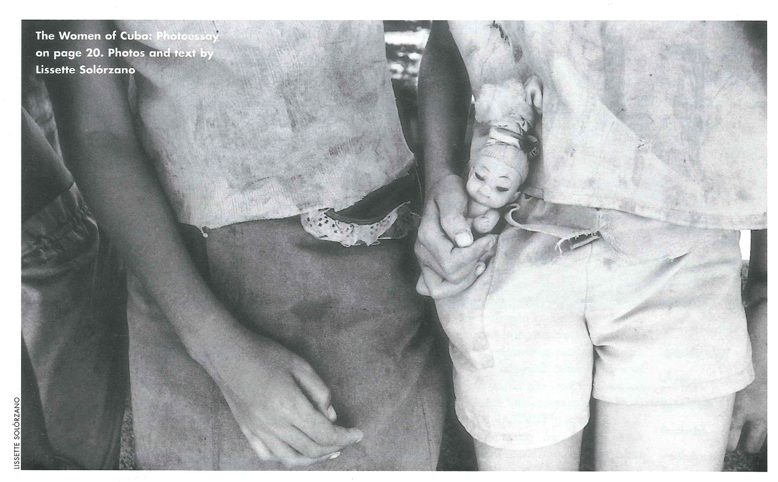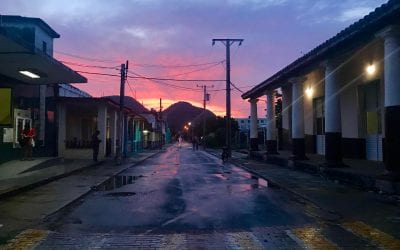Cuba Today
Linking the Island

Cuba is in. Things Cuban are fashionable and in vogue-what Bonnie Raitt suggested in her lyric “Cuba is Way Too Cool.” Cuban recorded music has once more claimed its place as a dominant presence in the U.S. market. Irakere, Los Van Van, Cubanisimo, and Los Muñequitos de Matanzas, among many other bands, have played to sold old venues across the United States. The success of the Grammy-winning album Buena Vista Social Club (Nonesuch) has been nothing short of remarkable. In mid-November 1999, Billboard magazine placed Buena Vista Social Club at the top of the pop catalog album sales, while amazon.com ranked Buena Vista Social Club at number 13 for sales at Harvard University.
Awareness of Cuba as a site of cultural innovation is at an all-time high. Art shows throughout the United States have exhibited the works of Carlos Estévez, Fernando Rodríguez, Manuel Mendive, and Salvador González. Cuba has become the stock in trade of mainstream media, not just as a topic of political reporting but as the subject of cultural news: Art Newspublished a feature piece on Cuban plastic arts; National Geographic marveled at the restoration of colonial architecture; aTime magazine feature was euphoric about the innovations of Cuban jazz.
Interest in travel to Cuba has soared. The Travel Cable Channel dedicated one program to the charms of Cuba as a tourist destination. A 1998 issue of Motor Boat and Sailing extolled the delights of sailing and fishing in Cuban waters. In August 1999, the Sunday New York Timestravel section published a front-page feature article on Cuba. The publication of Cuba travel guides and tour books has developed fully into a growth industry, while Cuba travel websites proliferate at a bewildering rate. What makes these developments all the more remarkable, of course, is that for most Americans travel to Cuba is illegal. It does not seem to matter. This is Prohibition all over again, where the law is routinely disregarded and defied. According to U.S. Interests Section sources in Havana, an estimated 100,000 Americans are traveling to Cuba annually, and many of them are doing it illegally.
Colleges and universities across the United States, largely in response to undergraduate curiosities, have established exchange programs with Cuban counterpart institutions. Study-abroad programs in Cuba, including summer projects and organized group tours dedicated to such diverse themes as Afro-Cuban religion, Spanish colonial architecture, performing arts, and rural health care, have proliferated. Scientific collaboration and academic cooperation between scholars of both countries have increased in numbers and types.
As this issue of DRCLAS NEWS, dedicated to Cuba, shows, Harvard is no exception. Its ties with Cuba are long and deep, and continue to expand. A hundred years ago, 1,300 Cuban teachers traveled to Harvard, becoming the news of the day, as Cuban writer Luisa Campuzano describes. More recently, until 1961, Harvard ran the lush Botanical Garden at Cienfuegos. Projects, trips, and academic exchanges are planned in most every corner of the university from the Medical School to the Graduate School of Design to Romance Languages and Literatures.
The links are not only through specific trips and exchanges, but through the intellectual effort of trying to understand a complicated society in transition. Jorge Domínguez, Harvard’s Clarence Dillon Professor of International Affairs, takes a hard look at last year in Cuba, while Abraham Lowenthal, a recent Weatherhead Center for International Affairs Visiting Scholar, puts Cuba into the larger context of Latin America. Susan Eckstein, Past President of the Latin American Studies Association and DRCLAS Research Associate, looks at issues of reform and resistance, while Cuba’s Soraya Castro, expected as a short-term DRCLAS Visiting Fellow this month, examines U.S.-Cuba relations. Harvard and Cuba are also linked through thesis work on Cuba in transition, such as that of Emma Phillips, an undergraduate in social anthropology and Ariana Hernández, a University of Chicago doctoral candidate who is also a teaching fellow in Harvard’s History Department.
The larger implications of these links-at Harvard and throughout the United States-are not altogether difficult to decipher. As the governments of both countries remain hopelessly stalled on the issue of “normalization” of relations, people on both sides of the Florida straits have taken matters into their own hands. They will not be denied “normal” relations with each other or be deprived of the opportunity to pursue matters of common interest and mutual concern.
These exchanges constitute powerful forces, and in the aggregate work-often imperceptibly-to fashion the larger cultural context in which both the politics and policies of both governments must perforce function. Engagement cannot but foster the kinds of familiarities conducive to an appreciation of the benefits of “normal” relations. The ties between Cuba and Harvard-as well as Cuban ties with many other U.S. colleges and universities-contribute in important ways to hastening the arrival of the time when relations between both peoples will be “normal.” The trend is irreversible, for anything less is abnormal. The issue is not if but when: there is too much history for it to be any other way. The sooner the better, for everyone
Winter 2000
Louis A. Pérez, Jr. is the author of On Becoming Cuban: Identity, Nationality and Culture (University of North Carolina Press, 1999). He is the J. Carlyle Sitterson Professor of History at the University of North Carolina at Chapel Hill.
Related Articles
Isabelle DeSisto: Student Perspective
encountered the first obstacle of my trip to the Isla de la Juventud before I even left Havana. Since American credit cards don’t work in Cuba, I couldn’t buy my plane tickets online. But that…
Honoring Humanity: An “Interview” with Richard Mora
Mauricio Barragán Barajas: Why don’t we begin by having you introduce yourself? RM: Alright. I was born in East Los Angeles, and grew up in Cypress Park, a barrio in…
Tobacco and Sugar
“Tobacco and Sugar” is the course that focuses American literatures on the Caribbean, and that acknowledges the unavoidable importance of monocultures for cultural studies. Much of the…




